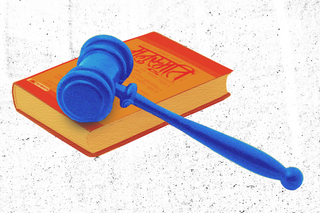
Delhi HC Judge Says ‘Manusmriti’ – An Ancient Text Criticized for Sexism, Casteism – Gives Indian Women Equality
The judge’s comment is the latest example of India’s fascination with the Manusmriti and the exclusionary laws it prescribes.

While speaking at the inaugural session of a conference on the theme of ‘Facing the unseen barriers: Addressing Challenges faced by Women in Science, Technology, Entrepreneurship and Mathematics (STEM),’ Justice Pratibha M. Singh of Delhi High Court opined that the Manusmriti gives Indian women equality. Singh went on to add that women were blessed because religious texts like the Manusmriti — an ancient law book that is criticized for its sexist and casteist content — give women a “respectable position” in society, reported Bar and Bench. The judge’s comment is the latest example of the Indian judiciary and polity’s continued fascination with Manu — considered to be the son of Brahma in Hindu mythology — and his laws.
The comment is a striking example of how religious fervor guides a judge’s thinking in assessing the plight of citizens. The Law Code of Manu, a 2004 publication by Oxford University Press written by Patrick Olivell offers some insight into the sexist and casteist nature of the text. For instance, the very first chapter of the text describes the four varnas of the Hindu caste system as originating from the different body parts of Brahma — the creator in Hindu mythology — explaining why they are unequal in terms of their jobs, social status, and the respect they command. While Brahmins are said to have come out of Brahma’s head, Shudras are born from his feet. Dalits do not even find a mention in this anatomy: they are outcastes.
The Manusmriti is no less bigoted in its position on women’s equality. It states in its fifth chapter that “Even in her own home, a female – whether she is a child, a young woman or an old lady – should never carry out any task independently. As a child, she must remain under her father’s control, as a young woman, under her husband’s; and when her husband is dead, under her sons.” In chapter 8, the position of women in society according to Manu is made evidently clear: “Wife, son, and slave – all these three, tradition tells us, are without property. Whatever they may earn becomes the property of the man to whom they belong.” These are just cursory examples of the extent of regressive ideas the text propagates.
And yet, Indian law and the text itself go a long way back, culminating in the present situation. The Manusmriti formed the basis of the East India Company’s Hindu Law code in the subcontinent. With Independence, the Indian legal system adopted Hindu Personal Law, which is an extension of the Company’s Anglo-Hindu Law, thus extending Manu’s influence on the personal sphere of the citizens of free India. Although Dr. B. R. Ambedkar and Jawaharlal Nehru — independent India’s first Law Minister and Prime Minister respectively — worked to reform some aspects of the law, they were initially met with opposition from a large proportion of the Parliament, eventually resulting in Dr. Ambedkar’s resignation from the cabinet over the Hindu Code Bill. Some aspects of that bill were realized as recently as this century, close to 60 years after Independence.
Related on The Swaddle:
Why Caste Is Essential to Understanding Marital Rape
In the last decade, the open endorsement of Manu’s ideas has seen a resurgence in the political space. On 5th August 2020, at the Bhoomi Poojan of the Ram Mandir at Ayodhya, a shloka from the Manusmriti was recited. Over a year later, members of the Hindu Nationalist outfit Bajrang Dal issued rape and death threats to journalist Meena Kotwal after she uploaded a video of herself symbolically burning a copy of the text on Twitter. The incident inadvertently dispels the notion of the text or its adheretns representing equality for women.
In 2018, legal scholar and then Vice Chancellor of the National Academy of Legal Studies and Research (NALSAR), Hyderabad posted a photo on social media of him paying tributes to Manu in Rajasthan High Court, where a statue of the mythological figure stands tall. More than three years later, he issued a clarification that he was surprised to see Manu’s statue in a High Court but maintained he was the greatest lawmaker of the land because of his influence on modern Indian personal law. In July this year, a research scholar from NIT Surat wrote an Op-Ed in support of Manusmriti. Justice Singh’s endorsement of the text, then, is just another addition to its increasing normalization in the country’s political landscape.
In his 1916 book, Castes in India: Their Mechanism, Genesis, and Development, Dr. Ambedkar writes about Manu, saying “I may seem hard on Manu, but I am sure my force is not strong enough to kill his ghost. He lives, like a disembodied spirit and is appealed to, and I am afraid will yet live long.” In 1927, eleven years after writing about Manu’s ghost, Dr. Ambedkar publicly burnt a copy of the Manusmriti. Yet, his public and vocal disavowal of the text and of Manu could not save him from often being hailed as a “modern Manu.”
The specter of Manu is thus omnipresent; arguably embedded into our institutions. Justice Singh’s comments, then, may be a worrying indicator of how the judiciary itself might view the role of marginalized citizens of the country. The Manusmriti, far from representing equality for women or marginalized castes, does the opposite: addressing this would mean reckoning with our own history.
Amlan Sarkar is a staff writer at TheSwaddle. He writes about the intersection between pop culture and politics. You can reach him on Instagram @amlansarkr.
Related


People Convicted of Crime Have a Right to Study: Allahabad High Court
